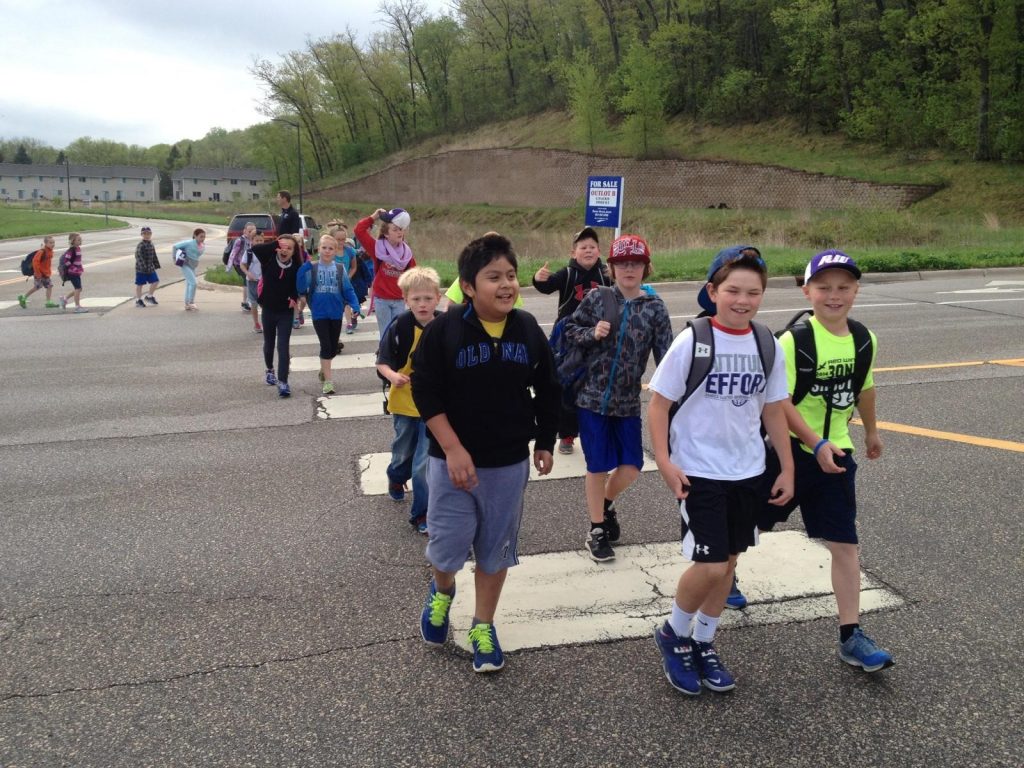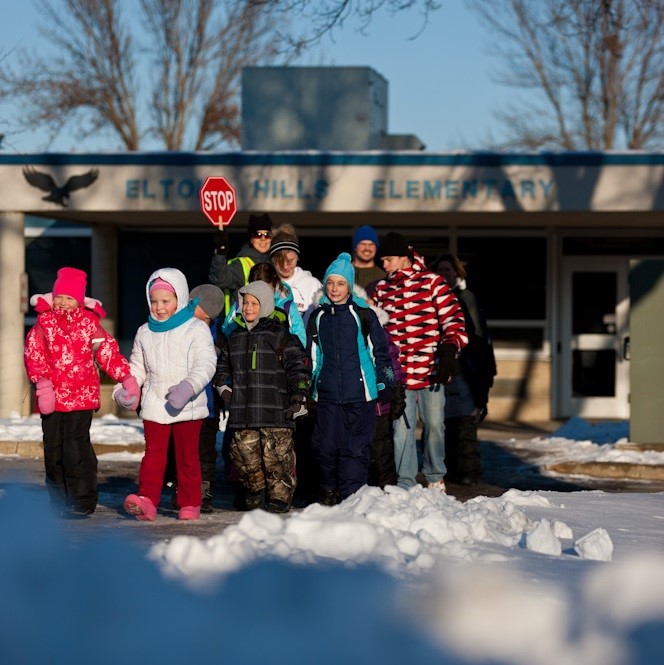By. Emily Houser
Green school advocates who aim to implement green, healthy, and sustainable practices at schools to accelerate student achievement can adopt principles and practices of Safe Routes to School to encourage green, healthy transportation to and from school. Making walking and biking to school the easy and safe choice can ignite a lifelong spark in students and instill healthy, green transportation habits they’ll carry with them the rest of their lives.
History and Background of Safe Routes to School
Safe Routes to School (SRTS) aims to make it safer, easier, and more fun for kids to walk, bike, and roll to school. The concept of SRTS originated in the 1970s in Odense, Denmark in response to a high rate of bicyclist and pedestrian injuries. Forty-five schools in Odense identified specific traffic hazards; in response, the city created a network of pedestrian and bicycle paths, narrowed roads, and implemented other measures to make streets safer for people walking and biking. Over the next ten years, the number of school children injured decreased by more than 80%. SRTS took off in the U.S. in 2005, when Minnesota congressman James Oberstar led a bill that approved funding for SRTS programs in all 50 states and the District of Columbia. These SRTS programs use a comprehensive “6 Es” approach (Engineering, Education, Encouragement, Enforcement, Equity, and Evaluation) to create a culture of walking, biking, and rolling to school where this is the safe and easy choice.
How Does this Relate to Green Schools?
SRTS is a natural fit with initiatives that support school sustainability and student health. Walking, biking, and rolling to school contribute to a sustainable school transportation system. School buses and personal vehicles cause emissions and traffic congestion – it follows that decreasing the number of people coming and going this way improves air quality around schools, reduces traffic congestion, and creates a safer space for students to walk, bike, and roll. Walking, biking, or rolling to school also contributes to healthy school communities by providing a portion of the 60 minutes of recommended physical activity kids should get each day so they arrive at school refreshed and ready to learn. Getting kids started walking and biking for transportation from a young age can help them develop lifelong sustainable, healthy habits.
Historically, walking or biking to school was the norm for a large number of students in the U.S. In 1969, 48% of children ages 5-14 usually walked or biked to school, while in 2009, only 13% of children ages 5-14 usually walked or biked to school. There are two primary reasons for this. First, new school construction is being sited farther away from homes. Second, more traffic around schools leads parents to believe it’s unsafe to bike or walk to school, so they drive their children instead – a vicious cycle. SRTS aims to encourage more kids to walk or bike to school, thus creating the physical and school culture conditions that make it safe and fun to do so. Green school advocates who are interested in promoting sustainable transportation to and from school can support policies around school siting that keep schools located closer to the families they serve, rather than favoring new construction in outlying areas. A school’s location has the potential to affect the transportation choices of families for decades to come.

Beyond school siting, SRTS programs can contribute to a school culture of health and well-being by incorporating Walk and Bike to School Day events and walking and bicycle safety curriculum, among other activities. Educators and school leaders who are interested in promoting sustainable, healthy forms of transportation to and from school can:
- Start a SRTS team at their school.
- Advocate for smart school siting and promote active transportation to school in school or districtwide policies.
- Encourage inclusion of pedestrian and bicycle safety education in physical education curriculum.
- Consult their state SRTS program website for guidance.
Read on to see how Minnesota is helping its students to walk, bike, and roll to school.
Minnesota Safe Routes to School
For over 14 years, Minnesota has been inspiring kids to get active and have fun on their trips to school through the Minnesota Safe Routes to School (MnSRTS) program. Since 2006, the Minnesota Department of Transportation (MnDOT) has provided nearly $50 million of funding to schools and communities statewide for SRTS planning, infrastructure, and non-infrastructure grants that help communities achieve a well-rounded, “6E” program. Funded projects include:
- Support for creating a 5 – 10 year SRTS plan for a school or community
- Infrastructure improvements to slow the speed of traffic or improve pedestrian crossings
- Fleets of bicycles to be used in educational programming
- Hiring local SRTS coordinators to advance programs and projects
- Temporary installations of “demonstration projects” to pilot potential infrastructure solutions
The strength of the MnSRTS program shines in its promotion of statewide Walk and Bike to School Day events. Participation in Walk to School Day events across the state tripled between 2015 and 2017, with 224 schools participating that year. The program thrives on cross-sectoral partnerships. Since 2009, Blue Cross Blue Shield of Minnesota’s (BCBS MN) Center for Prevention has hosted a monthly SRTS Network Call and provided technical assistance to schools and communities. The Walk! Bike! Fun! bicycle and pedestrian safety curriculum was developed in 2012 in collaboration with MnDOT, the Bicycle Alliance of Minnesota (BikeMN), and BCBS MN’s Center for Prevention. Since then, 739 individuals have been trained to teach the curriculum and it’s estimated to reach over 71,000 students annually. The curriculum has recently been updated to be inclusive of, and adaptive to, the needs of students with disabilities and is currently being revamped with an equity lens.
Spotlight: Minneapolis Public Schools
Communities around the state have risen to the occasion and garnered support from school staff, administrators, and other community members to implement successful SRTS programs. One example of a highly successful SRTS program is Minneapolis Public Schools (MPS), which has developed a comprehensive SRTS program and strategic action plan with the support of MnSRTS and other partners. Led by SRTS Coordinator Jenny Bordon, MPS has grown a districtwide SRTS program with a focus on equity, partnerships, and creative solutions. Just over a decade ago, Jenny and her family coordinated with other families in their neighborhood to walk to school together, which was later formalized as a walking school bus (a coordinated group of students who walk to school together with a parent volunteer). Eventually, Bordon and her husband applied for a grant to support their walk-to-school efforts. In 2011, Bordon started working as MPS’ SRTS Coordinator and her grassroots neighborhood initiative grew into a districtwide program.

MPS has developed SRTS plans for schools such as Seward Montessori and Edison High School and revamped arrival and dismissal processes at many schools to prioritize students arriving by active modes of transportation. The district has created walking route maps, assembled travel plans, and promoted Walk and Bike to School Day events. They have also coordinated bike trains (similar to a walking school bus but on bicycles), bus stop and walks (the school bus drops students off some distance from school and they walk the remaining distance together), active commuting field trips, and the notoriously entertaining MPS Let’s Roll group bike ride. More than 40 of the district’s schools typically participate in Walk and Bike to School Day events. Much of the success of the MPS SRTS program comes from partnerships with City and County Public Works staff, the Minneapolis Health Department, BikeMN, and even a local bicycle part company that provides mechanical support for the district’s bicycle fleets. Bordon sits on the City’s Bicycle Advisory Committee and Vision Zero Advisory Committee, where she voices support for city-led infrastructure improvements that benefit schools. One of Bordon’s top priorities is equity, and she has worked to build coalitions with community partners working in areas such as social and environmental justice, disability rights, and health equity.
MPS is one example of how a school district, led by a creative, passionate champion, can work with partners to make great strides toward achieving a more sustainable and healthy school transportation system. If you are feeling inspired to promote SRTS principles at your school or district, take the first step and start a SRTS team!
Author Bio
Emily Houser is a Safe Routes to School Planning Intern at the Minnesota Department of Transportation. She received her Master of Urban and Regional Planning degree in May 2020 from the University of Minnesota, where she focused her studies on active transportation, sustainability, and public health. Emily’s interest in healthy, sustainable schools began before she started graduate school, when she worked for a small nonprofit as a school food and garden educator. Emily is passionate about planning for healthy, sustainable communities where making active travel choices is easy and safe.

